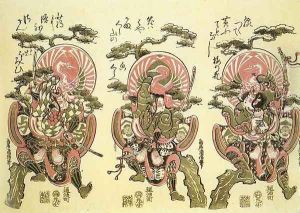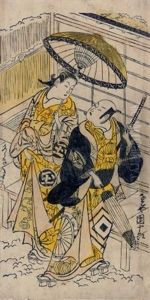Torii Kiyonobu II Paintings
Torii Kiyonobu II was a Japanese ukiyo-e style woodblock print artist, known for being a prominent member of the Torii school. This school was noted for its close association with the kabuki theatre, producing many prints that depicted scenes and actors from kabuki plays. Born in 1706, Kiyonobu II was the son of Torii Kiyonobu I, who had founded the Torii school and was himself a distinguished artist of the time.
Kiyonobu II inherited the leadership of the Torii school after his father's death in 1729 and played a significant role in developing the style and techniques of actor prints, which were a staple of the school's production. His works are characterized by their dynamic composition and bold use of line, capturing the energy and drama of kabuki theatre. He also worked on other genres such as bijinga (pictures of beautiful women) and occasionally depicted sumo wrestlers and scenes from Japanese folklore and literature.
During his lifetime, Kiyonobu II contributed to the evolution of the actor's portrait (yakusha-e), by incorporating a more realistic approach to the depiction of the actors and their costumes, while still maintaining the stylistic elements that were emblematic of the Torii school’s aesthetic. He also witnessed the transition from hand-painted to fully printed playbills and advertisements for kabuki theatre, and his work played a pivotal role in developing the visual language of these prints.
Kiyonobu II's career spanned a period of significant change in the ukiyo-e genre, as the increasing popularity of woodblock prints led to the development of full-color printing techniques, known as nishiki-e, towards the end of his life. However, most of his own work remained in the hand-colored or limited color range, known as tan-e and beni-e prints.
Kiyonobu II passed away in 1763, leaving behind a legacy that would influence subsequent generations of ukiyo-e artists. His work is noted for its historical significance in capturing the culture of Edo period Japan, particularly in the context of kabuki theatre. His prints are now considered valuable cultural artifacts and are held in numerous museums and private collections around the world.

